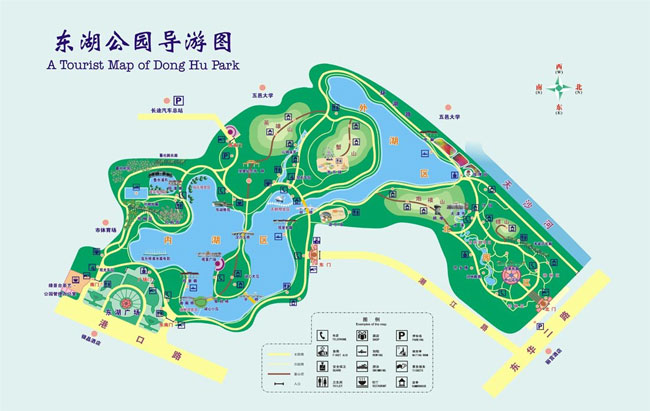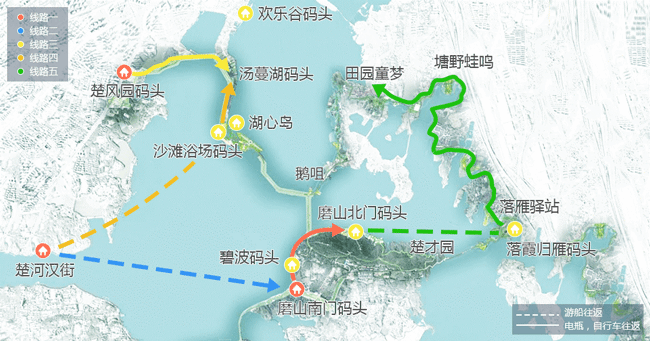Social Programme
Tourist Attractions in Wuhan
About Yellow Crane Tower

Yellow Crane Tower, located on Snake Hill in Wuchang, is one of the "Three Famous Towers South of Yangtze River (the other two: Yueyang Tower in Hunan and Tengwang Tower in Jiangxi).
Legend has it that in Wuchang, there used to be a wine shop opened by a young man named Xin. One day, a Taoist priest, in gratitude for free wine, drew a magic crane on the wall of the shop and instructed it to dance whenever it heard clapping. Thousands of people came to see the spectacle and the wine shop was always full of guests. After 10 years, the Taoist priest revisited the wine shop. He played the flute and then rode on the crane to the sky. In memory of the supernatural encounter and the priest, the Xins built a tower and named it Yellow Crane Tower.
According to records, the tower was first built in 223 A.D during the Three Kingdoms period (220-280). After completion, the tower served as a gathering place for celebrities and poets to party and compose poetry. It was estimated that up to the Tongzhi Reign of the Qing dynasty, as many as 300 poems about the tower had been found in historical literature. Cui Hao, a famous poet during the Tang dynasty (618-907), made the tower well known throughout China with his poem "Yellow Crane Tower".
Destroyed many times in successive dynasties, the tower was rebuilt time and again until 100 years ago when it was, for the last time, reduced to ashes. The present tower is a complete reconstruction and is the result of four years of work beginning in 1981. Where the old tower was only 15 meters wide, the ground floor of the new structure was increased to 20 meters wide. The tower, 51.4 meters high, is five-storied with yellow tiles and red pillars, overlapping ridges and interlocking eaves, more magnificent than the old one.
The new Yellow Crane Tower is regarded as the symbol of Wuhan city.
About East Lake Park
The East Lake which is located in Wuhan has beautiful landscape, unique and charming scenery. Having over 100 scenic spots, it can be divided into five major scenic areas, but now only open four scenic areas to visitors named Listening to Wave, Mo Hill, Blowing the Flute, and Falling the Wild Goose. The vast expanse of water which is said to be six times the size of the West Lake in Hangzhou has 12 small lakes, more than 120 islands, over 110km of shoreline twists and turns, then 34 rolling peaks around, and 10,000 mu of lush forest. The lake looks like a mirror, and the picturesque mountains look like the screen.
An important part of the famous Wuhan East Lake Scenic Area, Mo Hill, also called Millstone Hill, lies southeast of East Lake. The graceful east peak that looks like a millstone gave the hill its present name, Millstone Hill. Covering a total area of about 5 square kilometers, it boasts abundant plants and unique gardens, amid the culture of the State of Chu (one of the seven warring states before Qin (221BC - 206BC) in China's first feudal dynasty). Many charming scenes, such as Chutian Jimu (Looking at the State of Chu As Far As One Can See), Botanical-Viewing Garden, Tiantai Chenxi (Morning Rays of Heaven Platform), are located on the hill.
On the first peak of the Mo Hill stands the pavilion called Zhu De's Stele Pavilion. Two stories high, it is famous for a red stele lying in front on which is carved the epigraph of Zhu De (an important leader of the Chinese revolutionary period), and an attached horizontal board inscribed 'Zhu De's Stele Pavilion' by Guo Moruo. The second floor of the pavilion affords an excellent view of the beautiful lake.
At the entrance to the State of Chu's cultural sightseeing area is the City Wall at 23.4 meters (77 feet) tall and 11 meters (36 feet) wide. Chu people prefer the color red. The surrounding wall made of reddish-brown stones is magnificent in its primitive simplicity. The street of the Chu Market with special craftworks and distinctive local foods exemplifies Chu architectural styles. Not far from the Chu Market is the Chu Talent Garden, where over a hundred statues in the garden depict outstanding Chu litterateurs, scientists, myths characters and so on.
The incredible Botanical Viewing Garden lies on the south side of Mo Hill. More than 360 kinds of plants are nursed in 13 special gardens, such as the Plum Garden, Cherry Blossom Garden, Rhododendron Garden, etc., for viewing and education. Among them the most famous is the Cherry Blossom Garden which covers an area of 150 mu (25 acres), valued as one of the world's three cherry blossom capitals, together with Hirosaki in Japan and Washington D.C. in America. The 2006 Wuhan Cherry Blossom Festival offers top grade cherry blossoms plus rich and colorful activities in the garden that attract visitors from all over the world. The Plum Garden, listed as the top of the four plum gardens in China, is also worth a visit. March, April, and May are the best viewing months.
East Lake Park Tourist Map

Mo Hill Tourist Map


